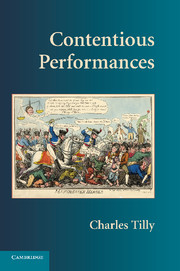Book contents
- Frontmatter
- Contents
- Boxes, Figures, and Tables
- Preface
- Contentious Performances
- 1 CLAIMS AS PERFORMANCES
- 2 HOW TO DETECT AND DESCRIBE PERFORMANCES AND REPERTOIRES
- 3 HOW PERFORMANCES FORM, CHANGE, AND DISAPPEAR
- 4 FROM CAMPAIGN TO CAMPAIGN
- 5 INVENTION OF THE SOCIAL MOVEMENT
- 6 REPERTOIRES AND REGIMES
- 7 CONTENTION IN SPACE AND TIME
- 8 CONCLUSIONS
- References
- Index
2 - HOW TO DETECT AND DESCRIBE PERFORMANCES AND REPERTOIRES
Published online by Cambridge University Press: 05 June 2012
- Frontmatter
- Contents
- Boxes, Figures, and Tables
- Preface
- Contentious Performances
- 1 CLAIMS AS PERFORMANCES
- 2 HOW TO DETECT AND DESCRIBE PERFORMANCES AND REPERTOIRES
- 3 HOW PERFORMANCES FORM, CHANGE, AND DISAPPEAR
- 4 FROM CAMPAIGN TO CAMPAIGN
- 5 INVENTION OF THE SOCIAL MOVEMENT
- 6 REPERTOIRES AND REGIMES
- 7 CONTENTION IN SPACE AND TIME
- 8 CONCLUSIONS
- References
- Index
Summary
The classified counts approach to contentious performances assembles catalogs of events, categorizes them, and computes frequencies of those events by time and place. One of the most impressive recent analyses in this tradition pinned down how nationalist mobilization helped shatter the Soviet Union. Concentrating on the crucial years from 1987 to 1992, Soviet specialist Mark Beissinger and his research team assembled massive evidence on Soviet and post-Soviet contention. His event catalogs included both relatively peaceful demonstrations and viciously violent confrontations.
Beissinger used his collection of episodes to untangle the disintegration of the Soviet state. As he put it:
The fundamental unit of analysis in this study is the contentious event. Although by no means the only method for dissecting contention, event analysis is widely recognized as a tool for studying waves of mobilization. It is essentially a way of tracking over time the rise and fall of particular types of events and the features associated with them.
(Beissinger 2002: 42)An experienced analyst of Soviet politics, Beissinger wanted to explain the enormous rise of separatist nationalism in the Soviet Union after 1986. Successful bids for independence on the part of former Soviet republics blew the union apart by 1991.
Beissinger could have written an interpretive history of the whole process. He chose instead to center his analysis on two large catalogs of episodes from the beginning of 1987 to August 1991: one of 5,067 protest demonstrations with at least one hundred participants, the other of 2,173 incidents in which at least fifteen people attacked persons or property.
- Type
- Chapter
- Information
- Contentious Performances , pp. 31 - 61Publisher: Cambridge University PressPrint publication year: 2008

